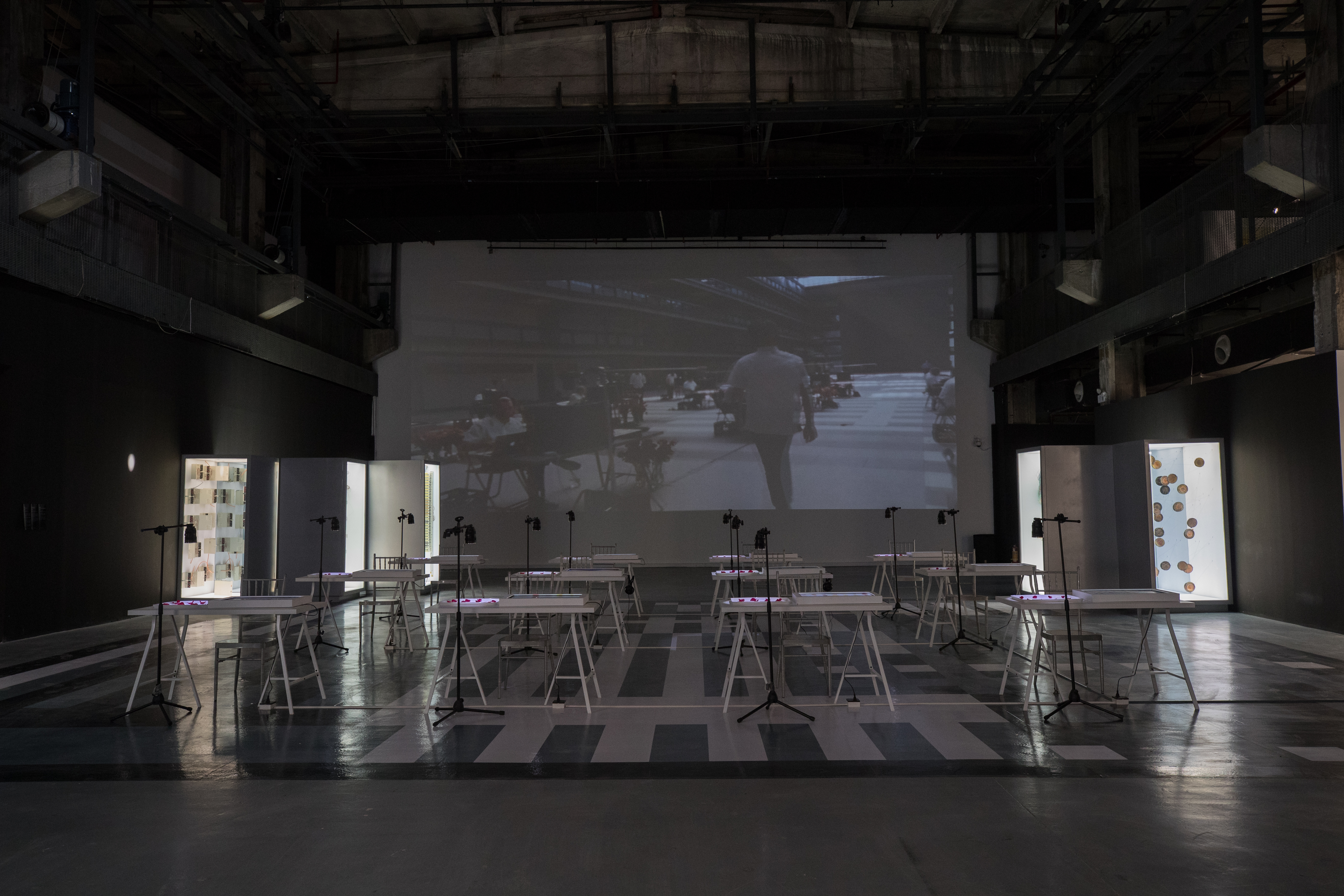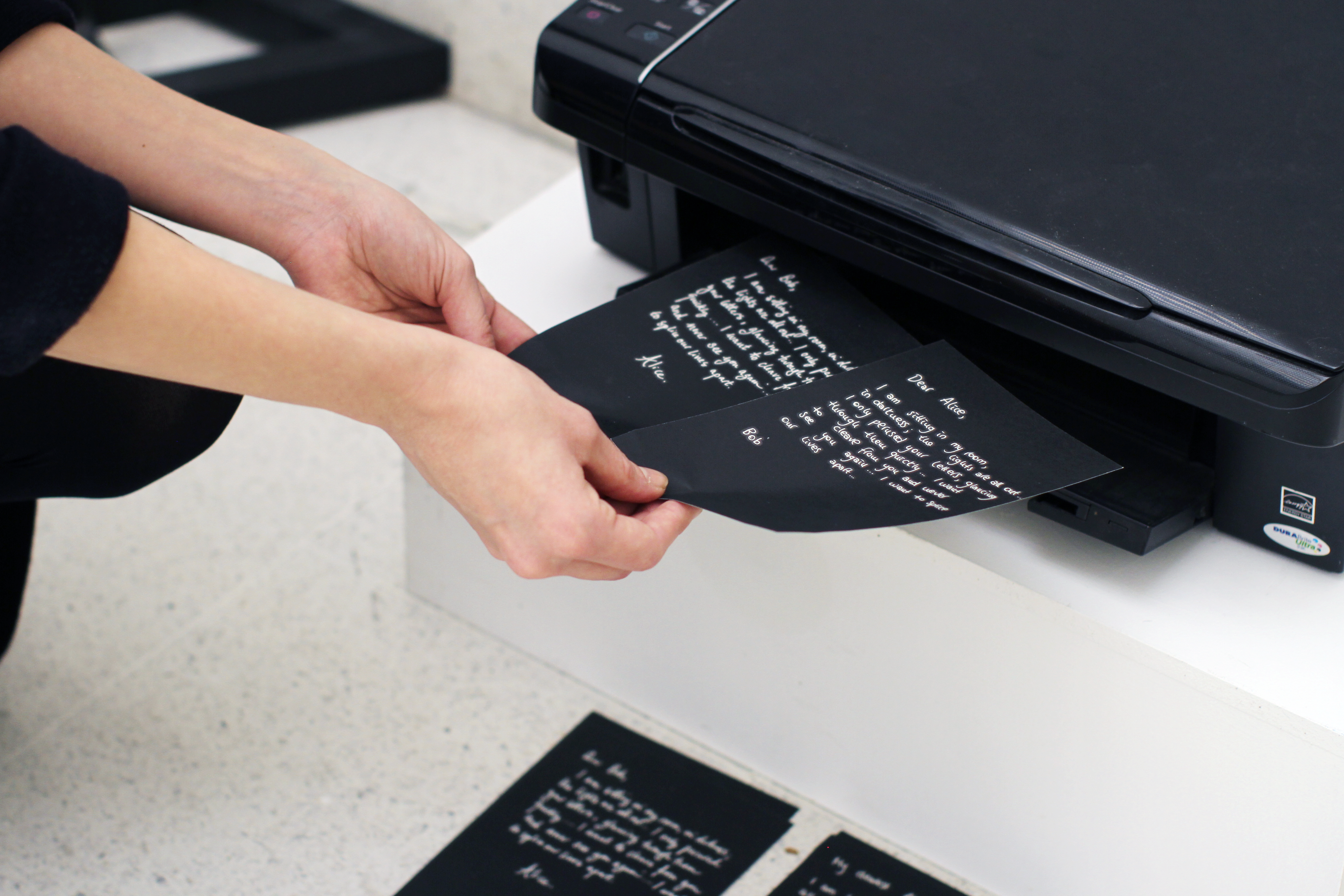MIND THE DEEP: Artificial Intelligenge & Artistic Creation
脑洞: 人工智能与艺术创造
7 NOV 2019 - 09 FEB 2020


Abstract | Mind the Statement
摘要
本次展览通过对22组艺术家,共28件作品,提出人工智能如何成为艺术创作的思辨框架,渗入艺术创作在观念,逻辑,工具和效应等层面,剖析在艺术范畴内被广泛使用的概念、算法与人工智能学科全景的关联,并探讨上述因素如何回应沉浸在技术环境中的无意识。同时,通过一系列人工智能学术会议的技术展示,探讨艺术家所使用的算法工具如何更直观、更具体地和当下生活
The exhibition “Mind the Deep: Artificial Intelligence and Artistic Creation” features 28 artworks by 22 artists and artist groups, together with demonstrations from AI conferences, to investigate how artificial intelligence has entered different levels and stages of artistic creation: concept development, logical construction, specific tools, and effects. Further more, the exhibition also elaborates how artificial intelligence associates itself in the concealed brain circuits of our lives nowadays, as well as the collective unconsciousness that is immersed in t
he Technocene. Meanwhile, by featuring tech-demos of artificial intelligence conferences, the exhibition explores how the algorithms can relate to contemporary life in a more straightforward and concrete way.

Introduction | Mind the Curatorial
简介
我们共享着图灵的领土。存储、寻址、执行、循环、递归、条件、“与或非”以及错误,不仅是现代编程携来的新知识和工具,也是被注入今日生活的隐秘脑回路,它支配着手机软件之间的每次无意识跳转,对流程管理的迷恋,对导航的信赖和诸多看似不假思索的决策。海量数据挖掘和高性能计算环境使得以神经网络为代表的新一轮人工智能技术呈现不可思议的有效性,并迅速在产业应用层级铺陈开来。运算系统蔓延至星球尺度,然而,这一似乎乘风破浪的技术,也承载着过量的交互与不可统计的漏洞,模棱两可,误差与滥用。
根据部分学者的研究,人工智能可以被粗分为十六个具体领域[1],涵盖机器学习、自然语言理解、神经网络、专家系统、运算理论等方向。人工智能定义的外延一直在形变,其分支和占主流地位的模型也生长出更为复杂的脉络,但它本身并不比基础科学更难被普及——今天的世界见证了更为精明的消费者,和对数据与隐私更谨慎的用户的诞生,也目睹了对人工智能有所觉察的一代人的出现。“知识”的定义被重新看待,证据和直觉之间的边界被重塑,图像与文字被映射在同一个可计算的空间。最终,人们也逐渐形成对人工智能的独立价值判断。
如果我们回到二十世纪初期,会发现许多颠覆性的概念绝不会停留在学科内部,而会成为更基础性的,共享的学科遗产。在这一点上,海森堡,香农与贝塔朗菲或许已经证明过:控制论与系统论的思想方法渗透到了从计算机科学、神经生理学到传播学的几乎所有自然与社会科学领域,不确定性原理甚至影响了对世界的底层理解。同样地,人工智能并未停留在计算机科学领域内部:自2010年前后起,许多艺术家开始注意到人工智能给世界所增加的复杂性,机遇与偏见,开始近观人工智能模型对既有“媒介”定义、工作方法和作者权的启发与挑战,并将其视为一种新的思辨框架。
Almost all of us live in Turing’s land. The functions of storing, addressing, execution, loop, iteration, “if”, “and/or”, as well as errors, are not merely new knowledge and tools brought about by modern computer programs, but also concealed “brain circuits” of contemporary life. They administer our every unconscious switch between mobile apps, catalyse our obsession with process management in daily life, magnify our trust of navigation apps, and guide decisions we seemingly make “without hesitation.” The magnanimity of data mining and the high-performance computing environment have led to unprecedented advances in artificial intelligence, in particular neural networks, which are expanding globally on an industrial scale. The computing system’s tentacles crawl over the whole earth. Yet, this unstoppable technology also brings with it an excess of interactions, uncountable loopholes, ambiguity, errors, and abuse.
According to some researchers, Artificial Intelligence can be roughly categorized into 16 realms, spanning over Machine Learning, Natural Language Processing, Neural Networks, Expert System, Computing Theory and so forth. The denotations of the term “artificial intelligence,” its branches and dominating models, are all evolving with time, yet the technology still finds its way to penetrate into the wider world: today’s world has witnessed the birth of a group of farsighted consumers, and users who are conscious of data and privacy. The definition of “knowledge” has been transformed, as well as the border of “evidence” and “intuition.” “Image” and “text” can fall into the same computable space. Eventually, independent judgement on artificial intelligence will be gradually shaped by each individuals.
If we revisit the early twentieth century, we will notice that no revolutionary concepts stayed in one narrow field. Instead, they evolved into more fundamental legacies shared across many academic disciplines—Werner Heisenberg, Claude Shanon, and Ludwig von Bertalanffy may well have proved this: the mentality of cybernetics and system theory have infiltrated almost every natural and social science fields ranging from computer science, neurophysiology to mass communication; the uncertainty principle even challenged our fundamental understanding of the world. Similarly, “artificial intelligence” never framed itself within computer science: ever since around 2010, artists have noticed how AI has brought to the world a higher level of complexity, chance and bias, and taken a closer look at how AI models has inspired and challenged the preexisting notions of “medium”, methodologies and authorship, forming a new type of critical, speculative framework.
[1] Becker et al. (2000),Singer et al. (2000), Chen and Van Beek (2001), Hong (2001) and Stone et al. (2001).
Main Purpose and Implementation | Mind the Map
主要目的和实施方法
展览一共邀请28件作品,其运用到的技术模型包括对抗式生成网络(Generative Adversial Network),StyleGAN(一种GAN),RaysGAN(一种GAN),自然语言处理(NLP)和各种其他类型的神经网络(Neural Networks),与此同时,作品也维持了包括绘画、雕塑、影像、装置在内的艺术语言。展览也邀请发表于2006年至2019年期间人工智能学术会议技术展示单元的作品,涵盖3维图像生成,基础数学问题解法,海量数据集模式提炼,声音环境侦测与学习等研究。
The exhibition invites 28 artworks which employs a wide range of artificial intelligence models, such as GAN, StyleGAN, RaysGAN, NLP and other neural networks and are manifested via accessible art forms such as paintings, sculptures, moving-images, and installations. The exhibition also features tech-demos selected from AI conferences between 2006 and 2019, encompassing research on 2D to 3D generation, algorithmic solutions to fundamental math questions, pattern recognition from massive data sets, sound detection, and so on.

- 训练永不止息
大厅作品召唤着一轮人工智能热潮背后,从贝尔实验室到谷歌的技术时间的返响。1946年,点接触晶体管在贝尔实验室诞生,以其为标志的微电子技术革命也开启了所谓的“硅文明时代”,贝尔实验室也是“艺术与科技实验”(E.A.T)的发源所。大厅两件作品皆指向人工智能训练背后专业“工种”的密集标注和普通用户提供的“微劳动”,并给抽象劳动和技术链条赋予了物理化身:工人们在今日荒无人烟的贝尔实验室旧址人工摘取花瓣并训练神经网络,五年内的谷歌验证码被打印成十多米长的风琴书。
-
Relentless Training
The works in the hall resonate with what’s behind the curtain of the current hype of atificial intelligence: the technological time constructed by Bell Labs and Google. In 1946, point-contact transistor was invented in the Bell Labs and marked the microelectronics revolution which engulfed us into a time of “silicon”. It was also at the Bell Labs that E.A.T was rooted. Two works located in the exhibition hall investigate the intensive data labeling in professional AI industries, and “micro-labor” by normal users, while endow the abstract labor and technology chain with physical embodiment: sixteen workers gather to photograph 100,000 rose petals in former site of Bell Labs, five leporello books chronicle every single captcha encountered by the artists in five years.


- 导航潜在空间
人工智能“潜在空间”(Latent Space)是指把高维对象投射到相对低维的空间里,以便表示低维空间中真实数据的变化或概率关系。这个“空间”同时也是基于运算的,二层的作品遍历从AVA到在线3D打印社区在内的各式各样公开数据集,探索着从经典画作,新闻封面到谷歌街景等训练数据所构成的特征空间,创造出商业人工智能算法通常无暇顾及的“不存在的风景”与“被数据侵蚀的日常”,探向均质表面之下实际多极分化的世界图像和技术暗涌。
- Navigating the Latent Space
Latent Space in artificial intelligence implies a space where high dimensional objects are projected in lower dimensions to showcase the data patterns or relationships based on probabilities. This “space” is also computational. Artworks on the second floor traverse various open datasets ranging from AVA to online 3D printing communities, and explore the feature space constructed by all sorts of training data: classical paintings, news front-pages, and Google street views, constructing an “invisible landscape” and “data-eroded everydayness” and diving into the technological undercurrents and disintegrated, multi-polarised world image beneath the homogeneity.


-
创造神与外星人
Catherine Jones指出科学家们也已经从对生命特征的“局部模拟”而转向“对智慧的主张”。这种膨胀野心的集中体现或许是谷歌的DeepMind。“劳伦”和“人类研究”构建了人与机器的角色反转与镜像。在“火星萨满”,“闭环”,“爱丽丝和鲍勃”,“我们集体意识的守护者”等作品中,智能机器成为我们创造的外星人或者具备神性隐喻的存在,成为今日唯物主义与技术导向的生存观之下新的形而上投射。原本用来执行任务的算法成为了通灵媒介,用来存储数据的“云”也承载了秘密与告解。
-
Building Gods and Aliens
Catherine Jones pointed out that xxx(original quote). “Lauren” and “Human Study” constructs the interchangeable and mirroring roles between human and machines nowadays. In “nimiia cétiï”,”Closed Loop”, “Alice&Bob”, “Keeper of our collective consciousness” and other works, the intelligent machine becomes aliens we created, a divine metaphor, and new ontological projections within the living attitude guided by materialism and technological submission today. The task-driven algorithms metamorphose into a spirit medium, the “clouds” Originally designed for data storage, now store our secrets and confessions.


-
人工遗产与美的假设
神经网络有能力“学习”,在这里,它“学习”的对象是人类所积淀的“理想原型”:数千年的古典雕塑,舞蹈影像,经典戏剧表演和互联网上被标注为“美”的人类脸孔。这一训练的结果却摇摆在超真实的美感与令人不适的恐怖之间。机器学习赋予了我们不断生产与合成新的美学遗产的能力,但如果完全服从这一逻辑,也可能走向多样性的消隐和“最常见属性”对他者的抹除,在作品里,“不太可能”、“不太常见的假设”仍然可以游荡。
-
Artificial Legacy and the Hypothesis of Beauty
Neural networks are capable for “learning”, hereby they learn from “ideal archetypes” accumulated throughout human history: classic sculptures of thousands years, dance imaginaries, theater performances, and faces labeled as “beautiful” on the internet. The result of such training, yet, vibrates between surreal beauty and unsettling, uncanny horror. Machine learning endows us with endless (even effortless) capabilities to produce and synthesize new aesthetic legacies, however, its logic also implies the retreat of diversities and the dominant feature erasing others. It is yet in such artworks that the “impossible”, the “uncommonly seen hypothesis”, are allowed to ponder.
Demonstration | Mind the Artists and Artworks
Conclusions | Mind the Exhibition
结论
“Mind the Deep”是对DeepMind的倒置。神经网络之”深“(层数)意味着极度复杂,使人“不知其所以然”的运算,而在通用算法领域最顶尖的DeepMind,与”意识”之深或许还相去甚远。如果说DeepMind是现状,那么Mind the Deep则是态度——“深”(Deep)的,百转千回的脑洞,需要关注(Mind),警惕(Mind),和心智(Mind)。
“Mind the Deep” reverses the word “DeepMind.” Depths (layers) of the neural networks imply extreme computing complexities and difficulties of comprehension. Yet the world-leading general algorithms developed by the company DeepMind, are perhaps still far away from “consciousness.” If we think of “DeepMind” as our current millieu, “Mind the Deep” is attitude—the “deep” brain circuits with thousands of twists, desire a “mind,” capable of consciousness, attention, and caution.
Acknowledgements | Mind the Team
展览名单
| 策展人: 邱志杰, 龙星如 主办: 明当代美术馆,中央美术学院视觉艺术高精尖中心数据艺术与人工智能实验室 联合主办:上海科技大学创意与艺术学院 参展艺术家及组合: aaajiao,阿尔伯特·巴克-杜兰 + 马里奥·克林格曼 + 马克·马赛尼特,安娜·瑞德尔 + 达莉娅·叶罗勒克,陈抱阳,克里斯蒂安·米欧·洛克莱尔,邓菡彬 + 吴庭丞,道格·罗斯曼,金·高更,杰克·艾维斯,拉比特姐妹,劳伦·麦卡锡,马修·普卢默·费尔南德兹,迈墨·阿克顿,迈墨·阿克顿 + 珍娜·苏特拉,奥斯卡·夏普 + 罗斯·古德温,帕特里克·特雷塞特,邱志杰 + 何晓冬,科斯莫工作室,莎拉·梅约哈斯,西尔维奥·洛卢索 + 塞巴斯蒂安·史梅格,施政,韦恩·麦克格雷格工作室 + 谷歌艺术与文化实验室 |
CURATORS: Qiu Zhijie, Iris Long
ORGANIZER: Ming Contemporary Art Museum (McaM),CAFA Visual Art Innovation Institute Data Art and Artificial Intelligence Laboratory
CO-ORGANIZER: School of Creativity and Art at ShanghaiTech University
ARTISTS & COLLECTIVES:
aaajiao, Albert Barqué-Duran + Mario Klingemann+ Marc Marzenit, Anna Ridler + Daria Jelonek, Chen Baoyang, Christian “Mio” Loclair, Deng Hanbin + Wu Tingcheng, Doug Rosman, Gene Kogan, Jake Elwes, LarbitsSisters, Lauren McCarthy, Matthew Plummer Fernandez, Memo Akten, Memo Akten + Jenna Sutela, Oscar Sharp + Ross Goodwin, Patrick Tresset, Qiu Zhijie + He Xiaodong, Qosmo, Sarah Meyohas, Silvio Lorusso + Sebastian Schmieg, Shi Zheng, Studio Wayne McGregor + Google Arts & Culture
References | Mind the Readinglist
参考文献:阅读清单
John von Neumann,The Computer and the Brain, New Haven/London: Yale Univesity Press, 1958
Caroline A. Jones,“In Praise of Wetware:Humans must truly understand intelligence to re-create it. ”
Hito Steyerl, “A Sea of Data: Apophenia and Pattern (Mis-)Recognition”
Fjodor van Veen, “Neural Network Zoo Prequel: Cells and Layers”
Adrian Mackenzie, Machine Learners: Archaeology of a Data Practice, MIT Press,2017
Matteo Pasquinelli, Alleys of Your Mind: Augmented Intelligence and Its Traumas, Milton Keynes: Meson, 2015
Pedro Domingos, Mel Foster: The Master Algorithm: How the Quest for the Ultimate Learning Machine Will Remake Our World,Basic Books, 2017
Ed Finn, What Algorithms Want: Imagination in the Age of Computing, MIT Press,2017
Memo Akten, “All Watched Over by Machines of Loving Grace. A digital god for a digital culture.”
